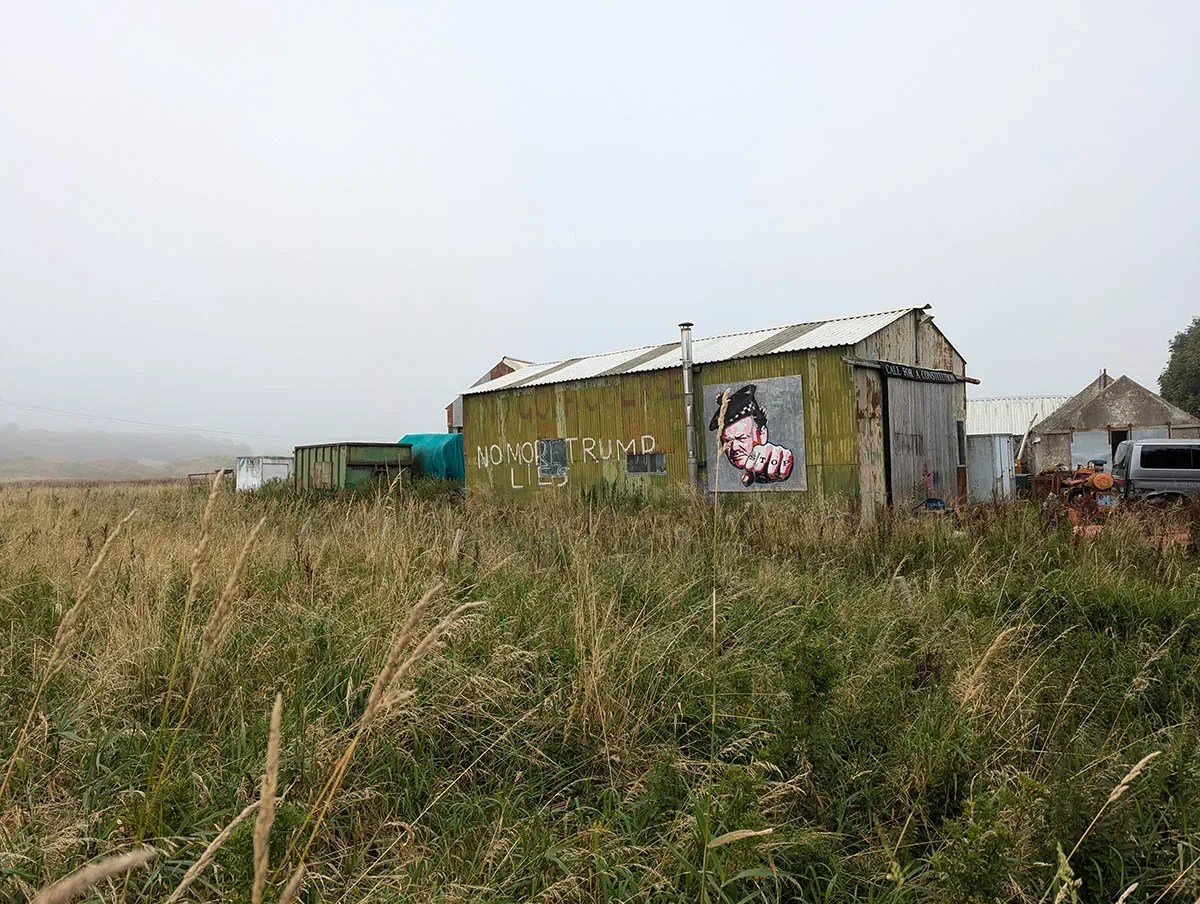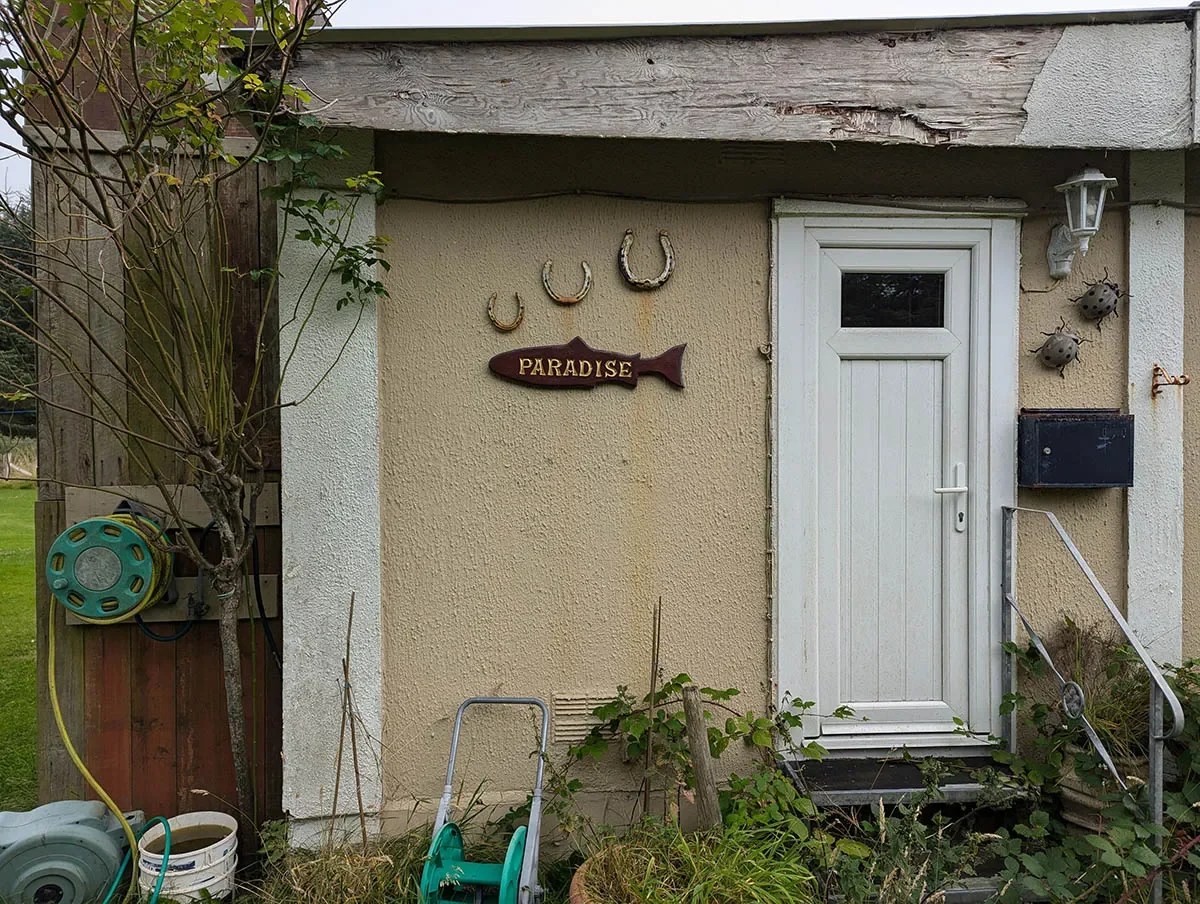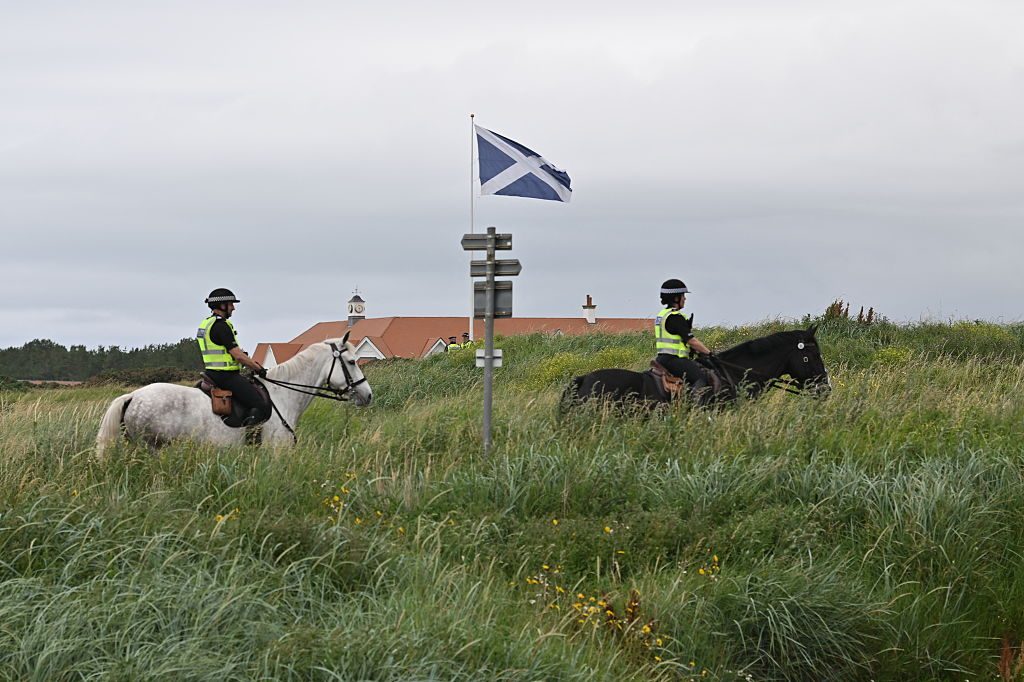Back in 2016, a writer in a Scottish local newspaper made a surprising prediction: Donald Trump would be the next American president. The Press and Journal doesn’t often cover foreign affairs, but this particular writer had insider knowledge. The headline read: “How Scotland will help me win the election.” The author was Trump himself.
In his article, Trump told the story of how he had built one of the “greatest” golf courses in the world, 10 miles north of Aberdeen. In the early days, Trump wrote, people “laughed when they saw what I had planned” — but eventually he convinced them. “Scotland has already been won,” Trump concluded. “And so will the United States.”
But had Scotland truly been won?
Last year, when I visited the Aberdeen branch of Trump International Golf Links — which lies just outside of the village of Balmedie (population: 2,500) — I discovered a very different story from the one Trump tells.
For almost two decades, a small band of Scots has resisted The Trump Organization’s efforts to turn their land into a playground for the super-rich. First he tried to buy them out, and then he tried to intimidate them — but they refused to uproot themselves for the sake of a billionaire’s bank account. This weekend, as Trump returns to Scotland to visit his beloved golf courses, the rebels will still be there — refusing to budge.
***
As so often with Trump, the story starts in Trump Tower. It was 2005. On one side of the room sat Trump and his advisers, including two of his children, Donald Jr. and Ivanka. On the other was a former officer in the Scots Guards, an elite unit in the British Army, delivering the most important pitch of his life.
Neil Hobday was used to mixing with the rich and powerful but, Hobday told me, he was still nervous. Trump could be a fierce interrogator.
The plan, Hobday told Trump, was ambitious but simple. North of Aberdeen, near a small village called Balmedie, sat Scotland’s Sahara: an expanse of rolling sand dunes that tumbled down to the beach. The Scottish government had designated the dunes a Site of Special Scientific Interest — which meant that they couldn’t be developed. But for the right amount of foreign investment, both the government and the main landowner were willing to sacrifice their protected status.
Just imagine, Hobday suggested, if they were turned into a golf course?
Trump loved the idea and Scotland’s charm offensive began. In October 2005, first minister Jack McConnell flew to New York to try and win him over. The golf course, he hoped, would provide the greatest economic boom to Scotland since its oil and gas discoveries.
Within five months, a deal was secured. And so, without Trump even visiting Scotland, his Organization announced its intention to buy “an 800-acre stretch of stunning sand dunes” at the Menie Estate in Aberdeenshire. Along with thousands of jobs and £1 billion of investment, he promised two golf courses, a hotel, nearly 1,000 holiday homes and 500 other dwellings. Sean Connery, he claimed, would hit the first ball. His membership number would be 007.
But all of this was predicated on local approval — and while Scotland’s national government had been seduced by Trump’s promise of foreign investment, the Aberdeenshire council still wasn’t convinced. Normal, rural people would be uprooted by construction, it warned, and the sand dunes irreparably destroyed. The proposal was rejected.
But local opposition was never going to stop Holyrood. And a week later, it stepped in, announcing that it had “called in” the proposal — a euphemistic way of saying that they, not the council, would have the final say.
In the year that followed, representatives of the Scottish Parliament flew back and forth to New York, where they dined with Trump and feasted on his vision. Chief among them was the future head of the Scottish government, Alex Salmond, then the representative for Aberdeenshire. Whatever was discussed, it wasn’t made public, though in March 2008 an official inquiry into the deal described Salmond’s behaviour as “cavalier”, and a sign of “exceptionally poor judgment”.
Nevertheless, later that year, on 16 December, a well-fed coterie of Scottish ministers granted The Trump Organization its planning approval. And in October 2009, construction at Trump International Golf Links began.
***
High above the 18th hole of Trump International, on a ridge that stretches into the sea, sits a decommissioned coast-guard station. David Milne, 60, the one-time cowboy actor, first bought the home with its quarter acre of land in 1992, and lives there with his wife.
For him, the story starts towards the end of 2005, a couple of months after Hobday’s trip to Trump Tower, when Milne received a phone call from a man called Peter Whyte. Whyte described how, after going shooting nearby, he had fallen in love with the area and wanted to buy a holiday home. Would Milne consider an offer?
Milne politely declined, and forgot about the incident until, in February the following year, Whyte turned up at his door and repeated his request. Milne declined again.
Only later, after a suspicious neighbour decided to look up Whyte’s number, did it become clear that he didn’t exist. It was an alias used by Hobday.
The deception, Hobday told me, was deemed necessary to avoid residents asking Trump to pay more than market value. When I asked him to clarify who made the decision to use such tactics, Hobday claimed it was the result of a conference call with “people in Trump’s office”. (The Trump Organization did not respond to requests for comment.)

After the plans for the golf course became public, The Trump Organization openly tried to persuade the residents to sell their homes. In 2007, Milne was issued a formal offer of $230,000 for his property, which he rejected. Some of his neighbours caved, with half of the 10 or so households accepting offers on their properties, while the others held out.
At this point, the local media was on Trump’s side, with The Press and Journal lobbying hard in favour of the project. When the council voted against the course, the Evening Express attacked council members under the front-page headline: “You traitors.”
The fact that Sarah Malone, the Scot who served as executive vice president of the development, would later marry the editor of The Press and Journal, wasn’t lost on Milne. “It sort of explains why the local media wasn’t playing fair,” he said.
And so, the course was going to be constructed — even if it had to be built around the resisting households on the Menie Estate. When the diggers finally arrived in July 2010, Milne said, they assembled two-story mounds around each of the resisting properties. The sunlight was blocked from their homes. Sand leaked into their windows.
“At one point, they came in and ripped out the original coast-guard fence and replaced it with a new one,” said Milne. “And then they sent me a bill asking me to pay half for it.”
In the early days of construction, Donald Trump Jr. was a regular fixture in Aberdeenshire, knocking on residents’ doors every few weeks to see if they’d changed their minds about selling their properties. Meanwhile, Milne was offered a lifetime membership to the golf course, and the opportunity to buy one of the new houses, provided he sold his home for an increased offer of $300,000. He claims the second offer was less than half the value of his house. But even if it had been double, he said he wouldn’t have accepted.
Trump’s son grew increasingly frustrated. According to Milne, on one occasion he said: “The golf course is going to happen. You’re getting in the way. We’ll just bulldoze you like we do with the earth.”
But Milne would not be moved: “As I told him at the time, the only way I intend to leave is horizontally in a box.”
***
The first time Trump met Michael Forbes, he offered the fisherman a job on his golf course. Trump then offered to buy his home and build him another one. “I sussed him out in about two seconds,” Michael says.
To the untrained eye, the Mill of Menie may seem like every other farm on Scotland’s windswept eastern coast. The house is pebbledash, the yard dotted with chickens and rusty tractors. When the sky is clear in spring, you can see skylarks and linnets. Summers, though, are ruled by the Haar, the all-consuming fog that climbs out of the North Sea. Yet even through the Haar, you can see the graffiti on Michael’s outbuilding. “No more Trump lies,” it reads. “No golf course.”
When he first heard of Trump’s plan, Forbes lived here with his wife, Sheila, and his mother, Molly, who was in her early eighties — and, he tells me, she was even more outraged by the destruction of their community than he was. “She loved this place,” Forbes told me, showing me the annex she used to live in. “She called it ‘Paradise,’ ” he said, pointing to the sign hanging next to the door.
Despite Trump’s offer, the Forbes family refused to sell their land. And as the golf course began taking shape, various authorities turned up at the family’s doorstep, investigating reports that he kept an unlicensed gun, or hoarded flammable liquids. None was true, and Forbes said he’s confident he knows who made the initial reports. “They were trying everything to kick me out,” he added. (Neither the police nor the Scottish Environment Protection Agency responded to a request for comment.)
The Trump Organization was perfectly open about its desire to bulldoze the locals. It would later lobby Aberdeenshire Council to use its compulsory purchase powers to force out the residents. The threat still hangs over the community. “It has never been formally withdrawn,” Milne told me.
“The Trump Organization was perfectly open about its desire to bulldoze the locals.”
Faced with partisan local media and an impotent local council, the Trump resistance — which consisted of the endangered residents and a few local supporters — started to hold meetings at Milne’s house. In July 2009, they set up a website, and started sending bulletins to the national press. The campaign was called “Tripping Up Trump”, and within months, Scotland’s people had begun to rally behind them.
Protests were organised on the dunes; anti-Trump badges and pens were sold; Mickey Foote, the late producer of The Clash who lived nearby, was particularly outspoken. By 2010, a group of individuals — including Lord David Puttnam, the filmmaker who produced Chariots of Fire — supported the mass purchase of a parcel of Forbes’s land, to protect it from compulsory purchase.
Trump was infuriated. Forbes, he told the press, was “dirty, sloppy, and unkempt”. His house, Trump added, was “slumlike” and “disgusting”; Forbes “lived like a pig”. Forbes still laughs at this final barb: “Pigs are very clean animals.”

And, he points out, if his family was unkempt, The Trump Organization was partly to blame. In July 2010, when his mother Molly, then 86, turned on one of Paradise’s taps, it let loose a trickle of sludge. The Trump Organization acknowledged that its workers had unintentionally broken a pipe that connected the Forbes’s home to the nearby well, depriving the family of clean water. But it claimed to have fixed it within 24 hours. Forbes disputes this, saying that the water remained contaminated.
Over the next five years, Molly would often have to walk 50 metres to a nearby stream and fill up a wheelbarrow with water when she needed to wash. Forbes claims that the pipe was only properly mended when he trespassed on Trump’s property to fix it himself, after rejecting the organisation’s offer to connect it to the main water supply rather than the well.
By this point, Forbes was a national hero. In 2012, he was voted “Top Scot” joining the ranks of Harry Potter author J.K. Rowling and tennis champion Andy Murray. When Trump got wind of it, he Tweeted that the poll was rigged; calling it an “embarrassment”, he banned Glenfiddich, the event’s sponsor, from all of his properties.
By then the course was finished. The first ball was hit at Trump International Golf Links in July 2012. Sean Connery was nowhere to be seen.
After the course opened, the resistance continued to engage in guerrilla tactics. In June 2016, Milne and Forbes hoisted Mexican flags above their properties — to show solidarity with “everyone else who Trump has derided, insulted, and intimidated”. Within days, messages of support arrived from Mexico — as well as more flags.
But for Forbes, this was a Pyrrhic victory. That year, during the height of the pandemic, both his mother Molly and wife Sheila died. Molly was 96; Sheila was in her sixties. Forbes is adamant that The Trump Organization’s campaign of harassment contributed to their deaths. “Of course it had an affect on their health,” he told me. The lack of fresh water; the sense of menace; the inevitable press attention — all, Forbes claims, took their toll.

This weekend, as an elaborately expensive security operation ramps up, Trump will open his second 18-hole golf course in Scotland. He will doubtless repeat his assertion that “it’s great to be home”. Starmer meanwhile will genuflect for the sake of tariffs and Scottish First Minister, John Swinney, thinks it is “in Scotland’s interest” for him to meet Trump.
But the majority of Scots would disagree. There is widespread anger at his politics, protests are planned and signs reading “Twinned with Epstein Island” are sprouting outside the links. Meanwhile, the small band of local resistors is bruised but undefeated and David Milne is still in place: “I’m going to sit up here with a beer and watch the circus,” he told reporters this week.
The circus, though, is a costly one. And not simply because of the security operation. None of Trump’s golf-course promises has come to pass. The resort has never made a profit; it lost more than $16 million over its first 11 years. It was supposed to provide “thousands” of jobs; today, there are fewer than 100 people employed there. A glistening mega-hotel was promised, but it is yet to materialise. Meanwhile, a number of Scotland’s leading cheerleaders for the golf course are showing signs of regret. Alex Salmond has publicly acknowledged Trump’s failure to deliver on his plan, while Hobday talked earlier this year of Scotland being “hoodwinked” by the American’s promise to invest $1 billion in the project.
But the locals weren’t hoodwinked. Mention the President’s Scottish heritage to any of them, and they start to bristle. The fact that the latest edition to his Scottish golf legacy is dedicated to his late mother, Mary Anne MacLeod, is particularly irksome. Almost everyone I spoke to mentioned the fact that, during his 2008 trip to his mother’s birthplace, 200 miles northwest of Aberdeen, he spent just 97 seconds in the home she grew up in.
“The whole Scottish thing is a joke,” said Milne, who points out that, before he decided to build a golf course in Scotland, Trump rarely visited the country.
Few, however, are as disdainful as Forbes. “He didn’t give a shit about his mother,” he roared when I mentioned Mary MacLeod. “He doesn’t give a shit about nobody but himself.”
***
This is an edited version of a piece originally published in The Free Press.
Sign up to Jacob Furedi’s Dispatch.

















